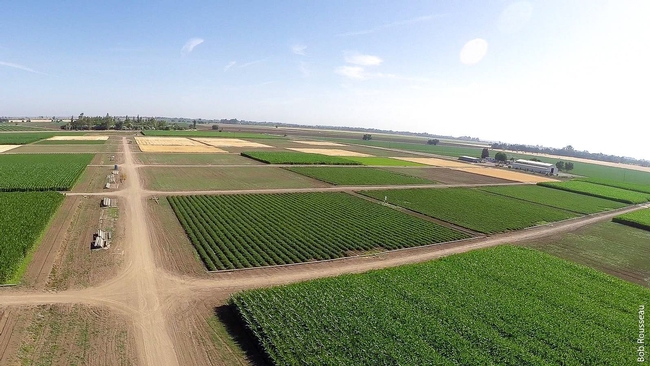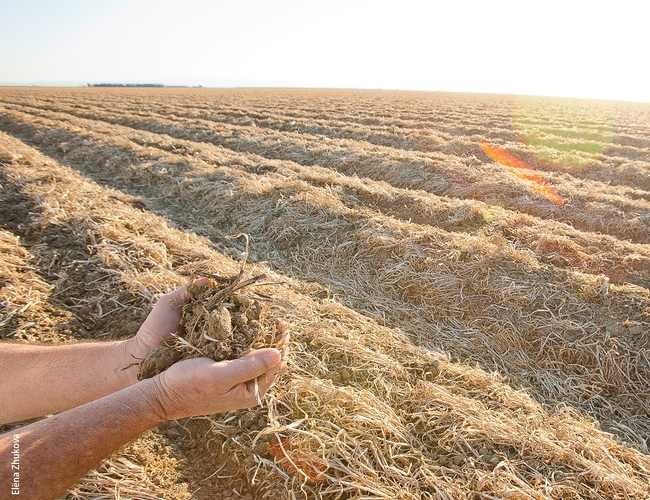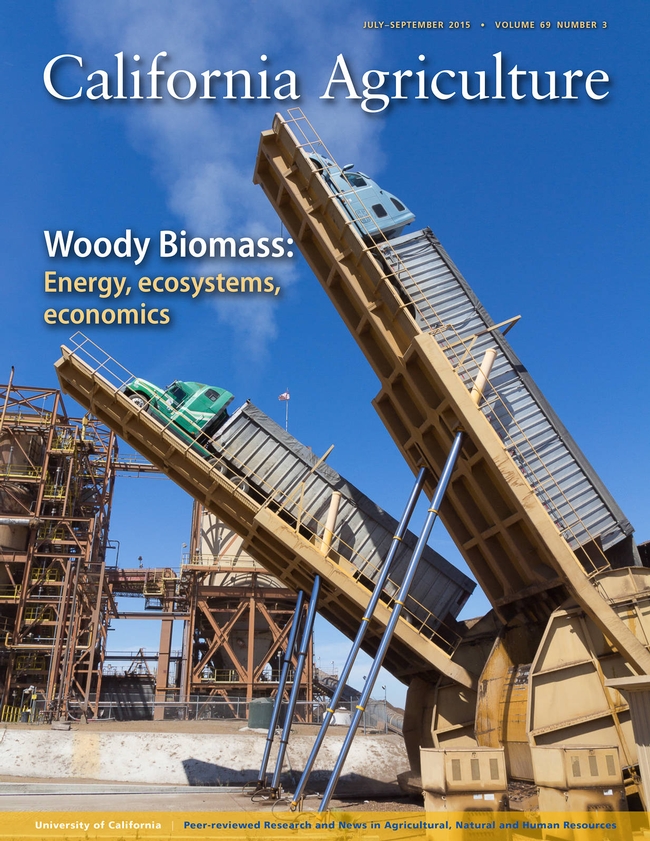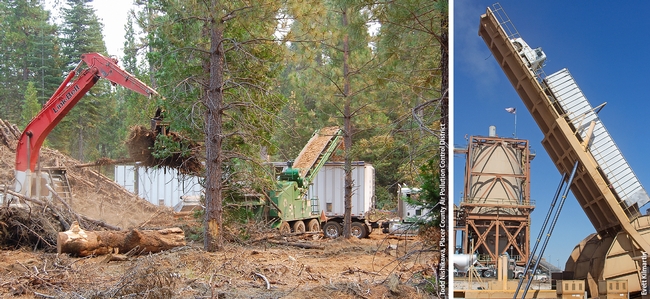Posts Tagged: California Agriculture journal
California agriculture contributes to and is impacted by climate change
Agriculture in California is on both sides of the climate change challenge. It is a sector that releases significant quantities of climate-warming greenhouse gases into the atmosphere. At the same time, it is vulnerable to the expected effects of climate change, including increased drought and flooding and more intense and longer heat waves.
Three review articles in the current issue of California Agriculture, the research journal of UC Agriculture and Natural Resources, summarize the state of knowledge on three topics at the intersection of climate and agriculture in California: agricultural resilience to climate change (“climate-smart” agriculture); cropland emissions of nitrous oxide, the most important non-livestock source of agricultural emissions; and opportunities for working lands to contribute to meeting state greenhouse gas targets.
The first article, Long-term agricultural experiments inform the development of climate-smart agricultural practices, discusses the research underway to incorporate resiliency in agriculture to extreme and unpredictable weather patterns induced by climate change.
The authors describe the “Century Experiment” at UC Davis. Established in 1992, the Century Experiment is a replicated research project that includes 72 one-acre plots planted to 10 different cropping systems. The plots will be monitored and data collected for a period of 100 years, but Californians won't have to wait that long to see results.
In the first 20 years, for example, testing has found that soil carbon increased significantly more in the organic tomato-corn system than it did in any other crops and management systems. Soil infiltration rates and aggregate stability were also greater in the organic than conventional tomato-corn system.
Soil amendments – such as agricultural and food wastes and winter cover crops – have led to increased soil carbon sequestration, higher infiltration rates and greater aggregate stability in the organic system, compared to conventional systems.
The authors believe maintaining healthy soils is a key to climate-smart agriculture. Properties such as porosity, water retention, drainage capacity, carbon sequestration, organic matter content and biodiversity all help to confer resilience to new pests, diseases and weather extremes brought on by climate change.
The second article, Nitrous oxide emissions from California farmlands: A review, presents the results of 16 California-based studies.
Nitrous oxide emissions are the largest direct source of greenhouse gases from cropland in California and nationally.
The studies reviewed in the paper indicate that the nitrous oxide emissions factor – the fraction of applied nitrogen that ends up being released as nitrous oxide – can vary widely depending on crop, irrigation method, climate and other variables. Accounting for these large differences is important in improving the accuracy of estimates of overall nitrous oxide emissions from farmland, and in designing measures to reduce those emissions.
The final article, Review of research to inform California's climate scoping plan: Agriculture and working lands, covers the range of ways that California's diverse agricultural systems can contribute to meeting the state's commitment to reduce greenhouse gas emissions by 40 percent from 1990 levels by 2030.
Slowing farmland conversion to urban uses and reducing emissions from the intensive livestock sector appear to provide the best opportunities for agriculture-related reductions. About two-thirds of direct agricultural emissions are from livestock production, particularly the dairy sector (the largest sector of the state's agricultural economy by annual revenue).
Because of the dairy sector's comparatively large contribution to agriculture's greenhouse gas emissions, the authors expect it to be a primary target for state climate regulations and incentives for emission reduction. They note, however, that policies should account for the already high levels of resource efficiency at California dairies.
The best opportunities for reductions in emissions from livestock operations center on feed and manure management. A report submitted to the California Air Resources Board says it may be feasible for California to achieve a 50 percent reduction in methane emissions from dairy if supportive practices are taken. Such practices might include:
- Switching from flush water lagoon systems to solid-scrape or dry manure management.
- Covering manure lagoons to capture biogas.
- Installing anaerobic digesters to capture and use methane.
- Use pasture-based dairy management.
The Legislature recently approved using $99 million in funds from the state cap and trade program to support the expansion of manure digesters and other technologies designed to greatly reduce emissions from livestock operations.
The review article also discusses potential for reducing greenhouse gas emissions from agricultural land in California by engaging in farmland and rangeland preservation, improved soil and nutrient management, integrating and diversifying farming systems, employing alternative practices in rangeland management and producing energy with biomass.
Climate change is impacting California tree crop farms
Rising temperatures appear to be reducing the number of hours tree crops in the San Joaquin Valley are subjected to chill during the winter, a critical factor in producing a profitable yield, reported Ezra David Romero on Valley Public Radio, KVPR-FM.
Pistachios, for example, require temperatures between 32 and 45 degrees for about 700 hours each winter, but for the past four years have had less than 500 chill hours.
UC Davis researcher Hyunok Lee recently published a study about climate change impacts on agriculture in UC Agriculture and Natural Resources' peer-reviewed journal California Agriculture. The study found that winter temperatures are increasing more than any other time of year. Her modeling looks at the year 2050 in Yolo County.
“Our agriculture will continue,” Lee said. “But if you look at . . . like 20 years or 30 years. The pattern may change a little bit, crops may move a little bit north.”
Romero spoke to UC Cooperative Extension farm advisor Craig Kallsen, who holds the UC Cooperative Extension Presidential Chair for Tree Nut Genetics. Kallsen is conducting trials aimed at finding pistachio varieties with novel nut, tree growth and yield characteristics, and varieties that produce a high yield even under low-chill conditions.
"We're trying to use the other species of pistachios actually to see if we can come up with something that has a low chill requirement. It's pretty hypothetical at this stage,” Kallsen told Romero. “We made quite a few crosses this spring and we actually hope to put a trial in a low chill area.”
David Doll, UC Cooperative Extension farm advisor in Merced County, is studying other tactics to improve winter chill, such as using overhead sprinklers to cool the trees and painting them white with liquid clay to reflect sunlight.
"So this is something that could impact a lot of farmers over the next 10, 20, 30 to 40 years,” Doll said. “And in fact it's already impacting farmers on random given years across the state."
California's new groundwater law leaves unanswered questions
The Sustainable Groundwater Management Act (SGMA) is a revolutionary law that will have profound impacts on the state's agriculture industry, however, it also leaves out many implementation details, according to Michael Kiparsky, director of the Wheeler Water Institute at UC Berkeley. Kiparsky authored the article Unanswered questions for implementation of the Sustainable Groundwater Management Act, which was published online by California Agriculture journal.
"SGMA is unprecedented, hugely impactful and a work in progress," Kiparsky said in a videotaped keynote presentation at the 2nd International Groundwater and Agriculture Conference in June 2016. The California Agriculture article is based on his remarks at the conference.
Kiparsky said SGMA defines sustainable management as avoidance of six specific undesirable results:
- Lowering of groundwater levels
- Reduction in groundwater storage
- Seawater intrusion
- Water quality degradation
- Land subsidence
- Impacts on beneficial uses of interconnected surface waters
SGMA relies on local control, with an "enforcement backstop" provided by the State Water Resources Control Board. New local entities called groundwater sustainability agencies (GSAs) will implement SGMA.
In the article, the author outlined what he considers the 7 most important unknowns about California's water future under SGMA.
- Governance. Decisions about governance and institutional design are being made now, so immediate attention to this question is imperative, he said.
- Translating sustainability goals into practice. "In many of the 127 groundwater basins governed by SGMA, the status quo is simply unsustainable," Kiparsky said. "The amount and patterns of groundwater use will need to change."
- Groundwater-surface water interactions. "Many groundwater users are expecting to augment water supplies by buying water within the basins or outside. Markets can be excellent tools for efficiency," he said.
- The role of markets. "Whether and how GSAs can design effective and fair markets as part of their efforts to achieve sustainability will be quite fascinating to observe," Kiparsky said.
- The role of data. SGMA empowers, but does not require, GSAs to collect groundwater extraction data from individual wells. The law requires only aggregated extraction data to be shared and reported to the state.
- The role of the State Water Board. Serving as "backstop" enforcement to the GSAs is a new role for the Board. "We don't know how it will approach the role in practice," Kiparsky said.
- "Significant and unreasonable." SGMA calls to avoid significant and unreasonable impacts, but it doesn't define the meaning of "significant and unreasonable." GSAs will need to define the terms themselves.
Kiparsky ended his article on a positive note with examples of research projects already underway aimed at helping meet the goals of SGMA legislation.
"Both projects illustrate how SGMA already is forcing and enabling creative thinking," Kiparsky said. "This type of creative thinking will be critical for California to implement SGMA successfully and transform from a national laggard in groundwater management into an international leader."
California Agriculture journal is the peer-reviewed research journal of UC Agriculture and Natural Resources.
What to do with woody waste in forests?
The destructive Rough, Valley and Butte fires have raised awareness of the abundant wildfire fuels in forests, leading to calls for thinning to reduce fire risk. But where should land managers put the small trees, limbs and treetops they remove? How does thinning affect forest structure, wildlife and pests? The latest edition of UC Agriculture and Natural Resources' California Agriculture journal contains a collection of peer-reviewed research articles on forest biomass energy, ecosystems and economics.
One way of disposing of the woody material is to burn it in biomass power plants to generate energy. However, nearly half of the power plants in California that run on woody biomass are operating on contracts that are set to expire in 2016, and low-cost solar power may deter utilities from renewing those contracts.
In his Outlook article, “The wood in the forest: Why California needs to reexamine the role of biomass in climate policy,” Peter Tittmann, academic coordinator for the Woody Biomass Utilization Group at UC Berkeley, writes, “By incentivizing better forest management and improved forest health, biomass energy leverages considerable climate and other environmental benefits beyond the direct reductions in carbon emissions from generating electricity from a renewable resource.”
UC scientists are evaluating the feasibility of using small, portable biomass power generators that could be moved to a forest thinning site, reducing the cost of transporting the biomass to a plant. Electricity generated in remote locations could be sold for a premium. Read more in “Following the fuel: How portable biomass energy generation may help rural communities.”
Peer-reviewed articles:
Forest biomass diversion in the Sierra Nevada: Energy, economics and emissions
In a Sierra Nevada case study, converting forest waste to electricity yielded energy and emission benefits, but was not economically viable. The authors suggest financial incentives for reduced air pollution could compensate.
Effects of fuel treatments on California mixed-conifer forests
Contrary to what some environmentalist advocates have argued, prescribed fire, mastication and thinning to modify wildfire behavior may have positive effects on the ecology of yellow pine and mixed-conifer forests.
Thinning treatments had minimal effect on soil compaction in mixed-conifer plantations
In mixed-conifer plantations in the Sierra Nevada, no large impacts were seen from commercial thinning or chipping treatments.
Modeling fuel treatment impacts on fire suppression cost savings: A review
Fuel treatments appear to reduce future fire suppression costs, but the savings are unlikely to fully offset the cost of the treatments.
To read all of the articles in the current California Agriculture, visit http://californiaagriculture.ucanr.edu.
California Agriculture is a peer-reviewed journal of research in agricultural, human and natural resources published by UC ANR. For a free subscription, visit californiaagriculture.ucanr.edu, or write to calag@ucanr.edu.
UCCE's healthy-eating guidelines readily available
UC Cooperative Extension's nutrition education programs were the feature of freelance writer Don Curlee's "Ag At Large" column last week. The column appears in a variety of publications, including the Hanford Sentinel, the Stockton Record, the (Sutter-Yuba) Appeal Democrat and Capital Press.
Curlee's article noted that UCCE has, "Knowledgeable, trained advisors ... on hand locally ... to help with meal planning, wise shopping, individual diet planning and overall nutritional health."
The column was prompted by the January-March issue of California Agriculture journal, a special issue focusing on "Healthy Families and Communities." In the opening editorial, former California Superintendent of Public Instruction Delaine Eastin said the state is facing a crisis in the health and education of its young people, Curlee reported.
“The challenges include high childhood obesity, rising school dropout rates and low student achievement, especially in the sciences," Eastin said. “Healthy families and children are vital to our nation and its prosperous future. It is time that key players in higher education join in a project to promote the general welfare by focusing on measurable scientific initiatives we can pursue to ensure the blessings of liberty to our posterity.”








